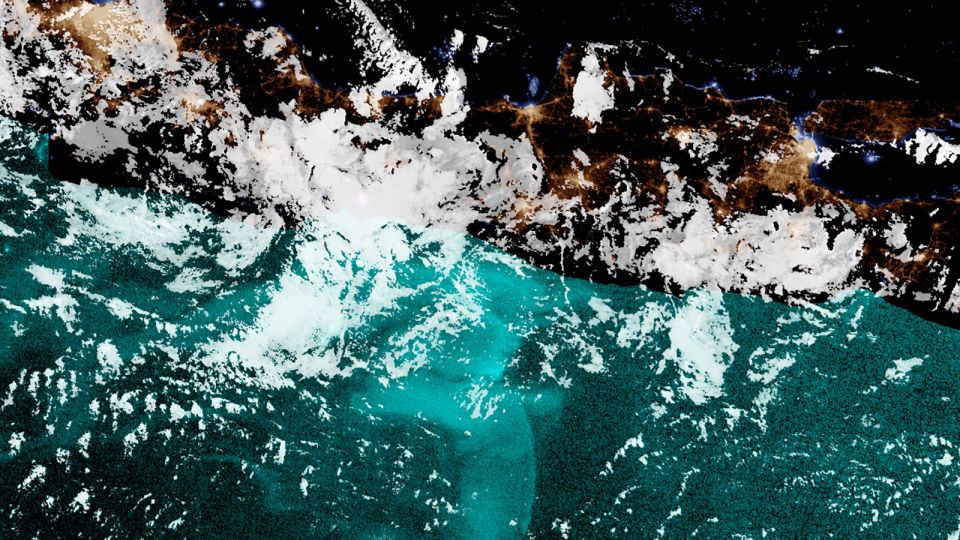Sign up for CNN’s Wonder Theory science newsletter. Explore the universe with news on fascinating discoveries, scientific advancements and more.
For over 400 years, sailors have reported a mysterious phenomenon in which the ocean appears to glow as far as the eye can see.
“The sea from horizon to horizon in all directions took on a phosphorescence glow … the moon had just set and the whole sea was several shades lighter than the sky,” wrote J. Brunskill, an officer aboard a ship called the SS Ixion that had sailed through the Arabian Sea in 1967.
Nearly 10 years later, another crew aboard a vessel named the MV Westmorland experienced a similar event in the Arabian Sea as it sailed through a “large area of bioluminescence,” according to the ship’s captain, P. W. Price. “The sea … glared a brilliant and bright green. So brilliant in fact that neither white caps nor swell waves could be distinguished from what appeared to be a perfectly flat sea,” he wrote in a letter in 1976.
These events, dubbed “milky seas” by the sailors who have been lucky enough to come across them, have been notoriously hard to study due to their rare occurrences in remote regions of the ocean where many humans are not around to see them.
Now, scientists hoping to better investigate the peculiar events are one step closer to predicting when and where these mysterious bioluminescent displays will occur. Justin Hudson, a doctoral student in Colorado State University’s department of atmospheric science, has compiled over 400 known sightings of “milky seas,” including those from Brunskill and Price, to create a new database that will help scientists one day get a research vessel to an event, according to a study published Wednesday in the journal Earth and Space Science.
“My hope is that with this database … more people will be able to start studying ‘milky seas’ and start unraveling this mystery that’s been around for centuries,” said Hudson, who is the lead author of the new research.
He added that further study of “milky seas” can answer the many questions that remain on the phenomenon, such as why they happen and what they could mean for ocean life.
“Milky seas could be a sign of something like a very good, healthy ecosystem. They could be a sign of an unhealthy ecosystem, and we just don’t know,” he added. “And so by being able to predict when and where they’re going to happen, we can start answering those questions about … where it fits in our whole global, interconnected Earth system.”
Bioluminescent bacteria
Observers often describe “milky seas” as similar in color to glow-in-the-dark stars put on the ceilings of children’s bedrooms. The glow the phenomenon emits has been reported by sailors to be strong enough to read by — a stark contrast to the dark ocean typically seen when there is no sun or moonlight. These events, which can last for months on end, stretch as wide as 100,000 square kilometers (about 39,000 square miles), and the larger ones can be seen from space, according to the study.
While scientists do not know exactly why this rare glow occurs, it is likely a byproduct of high concentrations of microscopic bioluminescent bacteria called Vibrio harveyi, according to the study. This hypothesis is based on a 1985 chance encounter by a research vessel that had collected and tested a water sample during a “milky sea” event.
“But besides that, the circumstances for how they form and how they set about causing the entire ocean to glow like that is still highly unknown,” said Dr. Steven Miller, study coauthor and a professor in Colorado State University’s department of atmospheric science. Miller, who has studied the phenomenon for decades, was the lead author of a 2021 study that found the larger “milky seas” could be detected via satellites.
After compiling all known records of “milky sea” sightings, which included historical records of eyewitness reports from sailors and satellite data, the study authors noted several trends related to the mysterious sea occurrences: Milky seas primarily appear in the Arabian Sea and Southeast Asian waters, and they may be impacted by certain global climate events, such as the Indian Ocean Dipole and the El Niño Southern Oscillation, Hudson said.
The regions where “milky seas” mostly occur tend to experience upwelling in the ocean, which is when the cooler, nutrient-rich water from the deep ocean is brought up to the surface due to strong winds. He predicts in these regions there are about one or so instances of “milky seas” a year.
“They are spots that are primed for lots of biological activity to happen,” Hudson said. “But there’s lots of places on Earth that are like that. So what actually makes (these regions) special is a huge, open question.”
The role of ‘milky seas’ in the ecosystem
“Milky seas” are different from the more common bioluminescent ocean events caused by a type of phytoplankton known as dinoflagellates. These organisms emit a blue glow when disturbed, such as when fish swim by or waves crash on the shore, in contrast to the steady glow emitted in the “milky seas” event.
While the phytoplankton flash in a defense mechanism, researchers theorize that the “milky sea” bacteria glow instead to attract fish — which then will eat the bacteria and allow the bacteria to thrive in the creature’s gut, said Miller, who is also the director of the Cooperative Institute for Research in the Atmosphere (CIRA) at Colorado State University.
Like many other scientists who have studied bioluminescence, Miller hopes to one day see the mysterious event for himself. Dr. Edith Widder, an oceanographer and marine biologist who was not involved with the study, has the same goal.
“I have spent my career observing and measuring bioluminescence in the ocean. I have seen some amazing light shows but I’ve never seen a milky sea. I really want to,” Widder said in an email. “By assembling this data base the authors bring us that much closer to being able to predict where and when a milky sea may occur.”
Widder, who is also the CEO and senior scientist for the Ocean Research & Conservation Association, wonders what effect the bioluminescent event has on other life in the ocean, particularly on the creatures that hide in the dark depths during the day and come up to eat only in the darkness.
“Light is a critical determinant of animal distributions and behaviors in the ocean. … What happens to that daily game of hide and seek when the animals that need to hide are illuminated by all that glowing bioluminescence? What is the impact on the carbon cycle? This is a natural experiment that has the potential to reveal a lot about the workings of life in the ocean,” she added.
There have been previous attempts at compiling databases of milky sea events, but each of these were eventually lost to time. With the new database, it “resets the benchmark for us in terms of our knowledge and awareness of where ‘milky seas’ are happening globally and over time,” Miller said.
During these mysterious bioluminescent ocean events, “the bacterial population is responding in this way that is so dramatic, and in a way that we hadn’t really anticipated could be possible,” Miller added.
Amongst the many unanswered questions that remain: Scientists don’t know how climate change affects the occurrence of the glow events, and how that can impact the ecosystem, he noted.
“We need to understand how that process is working … because, among many other things, bacteria and phytoplankton are associated with the bottom of the oceanic food chain — all the higher order species and fish are reliant on that food chain to exist. And changes in that food chain, based on changes in circulations of our planet, are things that we need to know about.”
For more CNN news and newsletters create an account at CNN.com
The post ‘Milky sea’ events mysteriously cause the ocean to glow. Scientists are trying to track them appeared first on CNN.




